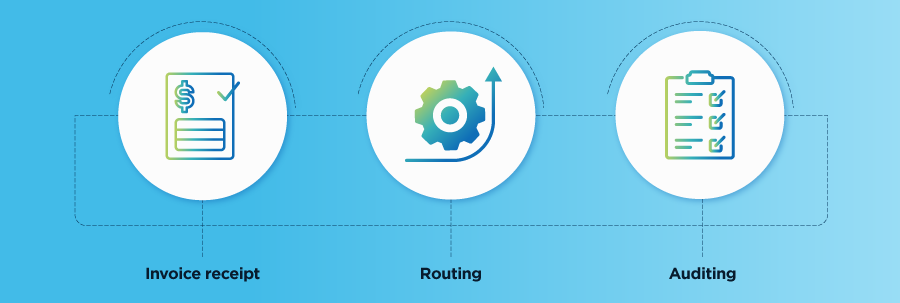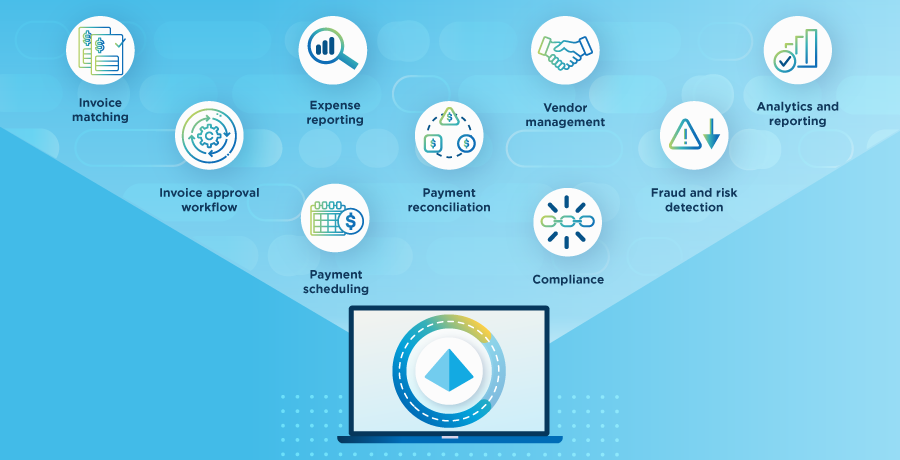How Intelligent Automation Makes Finance Easier

Finance teams know a manual accounts payable (AP) process tends to be tedious and therefore error-prone. Audits and worries about fraud prevail – it’s time to retire paper invoices and individual approvals. It’s time to adopt intelligent automation (IA).
What Is Accounts Payable Automation (AP Automation)?
Automated accounts payable solutions aim to improve business finances by optimizing accounts payable workflows to be more efficient, accurate, and stress-free. By minimizing the number of manual processes in your back-office financial processes, you’re improving your employees’ work levels, saving time, and opening your organization to better cash flow.
How does accounts payable (AP) automation work?

Invoice automation converts paper invoices into a digital format and routes them through your digital workflow automation based on the rules it’s been fed.
AP automation focuses primarily on three processes: invoice receipt, routing, and auditing.
- Invoice receipt: With automation, incoming invoices can be electronically received or converted from paper to electronic using document automation or intelligent document processing (IDP), which can be used for invoice scanning, reading and digitally converting.
- Routing: Once data is electronically captured, invoices can be matched to purchase orders or goods receipts, or be automatically routed to the relevant accounting team for the review and approval process. Once approved, the invoices are sent to the accounting software or enterprise resource planning (ERP) system for electronic payments/credit card payments.
- Auditing: Automation archives invoices and produces audit trails of the entire process. This streamlines financial auditing and ensures invoices are easy to look up so past information isn’t lost.
Organizations can also implement purchase order processing automation to automatically collect sales orders, extract information, and apply business rules – and these automation solutions can scale to other processes, including reporting, approvals, exception handling, etc.
Why Automate Accounts Payable?
AP is a critical function in any organization’s finance departments, and ensuring accuracy and speed are key to creating more efficient and reliable operations. Find out more about how you can use intelligent automation for finance and accounting across processes.
What are the challenges with manual accounts payable?
- Time-consuming: Traditionally, AP relies on manual data entry, where staff must physically key paper invoices into their accounting systems. This process is time-consuming and boring, and staff could be focused on higher-value initiatives.
- Costly: Manual AP processes can affect your cash flow and resource distribution. As the invoices stack up, payments may be late, leading to poor relationships with suppliers and late fees. That, or your staff may need to work overtime to manage the burden.
- Error-prone: These processes also come with errors inherent in manual work, including typos, duplicate invoices, and miscalculations. This leads to a change of errors that must be solved by employees, which can take even more time, undermine supplier and customers’ trust, and lead to auditing issues.
- Slow: Manual accounts payable processes can be very slow, causing delays. They rely on staff to be at their desks, with no breaks or vacations, sifting through mountains of paperwork.
- Disparate: With paper-based processes, financial management can quickly become confused with what’s been approved, what’s been paid, and when the deadline is. This leads to miscommunications and lost or misplaced invoices.
Why is automating accounts payable important?
As you can see, slow, error-prone, and disparate AP processes are harmful to an organization. It’s clear these processes need to be reconciled, lest you lose money to penalties and late fees or harm customer and vendor relationships.
What Are The Benefits of Accounts Payable Automation (AP) Automation?

Your accounts payable department can benefit from automation. It can help you stay agile in an ever-changing business landscape and keep ahead of the competition. Let’s look at some of the benefits of automation.
How can AP automation resolve invoice issues?
- Time savings: AP automation software eliminates many of the manual steps, creating more efficient, faster invoice processing. This reduces the amount of human intervention for each invoice, which saves time for your staff to focus on other value-driven work.
- Reduced costs: AP automation cuts invoice processing costs by reducing the time staff are spending on it. This cuts labor costs, which saves the organization time and resources, along with the costs of storing paper invoices, postage, printing, and so on.
- Improved accuracy: An AP automation solution reduces the risk of human errors, which then reduces payment errors, duplicated effort, and fraudulent or inaccurate payments. AP automation automatically validates supplier invoices against ERP systems early on and flags any inaccurate invoice payments before they’re made – saving the organization from refunds or more lost time.
- Increased efficiency: Automation streamlines the entire invoicing workflow and payment cycle, reducing approval times and increasing productivity. And since most accounts payable software integrates with existing financial systems, data can seamlessly flow between systems, leading to easier communication and better transparency.
- Better compliance: When you implement automation, you set the rules. You can input the compliance rules related to your industry to make processes more transparent and ensure any risks are flagged immediately.
- Improves employee satisfaction: Automation supports your accounting team by transforming admin activities into digital processes, empowering them to think bigger about their career, and how they can help the organization grow.
Find out more about how you can benefit from finance process automation.
How does AP automation improve the invoice process?
AP automation software can completely transform the invoice process, removing headaches for your accounts payable professionals, vendors, and customers, and saving you resources and money. These achievements will help you hit your business targets and develop a sustainable environment of growth and efficiency so you can expand to other office automation solutions.
What is the ROI of AP automation?
When deciding whether you want to automate your invoicing processes, it’s important to consider the return on investment (ROI). Calculate the initial cost of setup and the potential cost savings from adopting automation technologies. While calculating the ROI isn’t 100% accurate – there are tangible and nontangible benefits, and automation can affect numerous areas of a business – there are some useful points to consider on the financial and non-financial side.
On the financial side, consider the cost of:
- The entire invoice process
- Human errors
- Invoice status inquiries
- Missed or late payments
- Early payments
- Staffing
- Cash flow management
On the non-financial side, consider the ROI of:
- Better transparency
- Employee satisfaction
- Streamlined processes
- Centralized internal controls
- Improved business relationships
Calculating your ROI will help build your business case for automation.
How Can Accounts Payable Be Automated?

Start with ‘quick wins’ where you’ll see the most benefits from automation, such as payment processes and purchase orders. With a scalable AP automation program, you can then expand into further business processes and departments.
Top accounts payable processes to automate
These are the top AP tasks that will benefit from automation:
- Data entry: Automatic data capture is faster and more accurate than manual entry.
- Invoice coding: An intelligent automation process allows you to set rules to ensure the correct general ledger code is used for each invoice.
- Invoice matching: Invoices are automatically matched to purchase orders and receiving documents.
- Invoice approval workflow: Approvals are electronically routed to the right people.
- Payment scheduling: Automation ensures accurate and timely payments, helping you take advantage of early payment discounts and avoid late fees.
- Fraud and risk detection: IA can monitor transactions and flag suspicious activity or unusual behavior.
- Expense reporting: Automation can capture receipts, categorize expenses, and route them for approval so employees get timely reimbursements.
- Payment reconciliation: Automation can reconcile bank statements by identifying discrepancies and recording payments.
- Vendor management: An automated vendor management system maintains current vendor details and tracks communications.
- Compliance: Automation solutions can calculate tax and ensure proper documentation for compliance reporting.
- Analytics and reporting: Some accounts payable automation software offers real-time visibility to spending and cost savings. Business process management (BPM) software allows you to manage and monitor entire business processes and automations for actionable insights.
How do you automate an AP process?
Generally, organizations will implement an all-in-one accounts payable automation software. Most automation platforms offer cloud, hybrid, or on-premises hosting options so organizations can choose how they want to manage their systems.
Once you’ve chosen the automation tools suitable for your business needs, you need to create a business case to get your executives and stakeholders involved. Then, you need to train your AP department and other people in the business with change management initiatives to get everyone else on board with the technologies and lay out their roles and responsibilities. It’s a good idea to use an operating model to help you plan, deploy, and scale your automation program, such as the SS&C | Blue Prism® Robotic Operating Model™ (ROM2).
What software can help to automate accounts payable?
Accounts payable software usually includes dashboard and analytics tools to help you quickly manage your processes and identify any issues or bottlenecks. And since the invoice data is digitized and stored in a central system, it’s easier to search for and audit the information. Look for accounts payable software that:
- Aligns with your business goals
- Scales to meet your evolving needs
- Integrates with your existing systems
- Includes business spend management and cash management features
- Has a user-friendly interface with drag-and-drop build capabilities
- Can digitize documents
- Offers specific accounting tools
- Has high security and compliance standards
- Provides support and training
- Is customizable and flexible
To find out more, read our automation software guide.
What tools can be used to automate accounts payable (AP)?
Intelligent automation (IA) is the bread and butter for automating accounts payable, but there are variations in IA. Consider what level of enterprise or business software you need to suit your capacity and growth goals.
Can document automation or intelligent document processing improve AP automation?
Absolutely. Both can be used for electronic invoicing.
- Document automation turns your handwritten documents into electronic formats using machine learning (ML) technology. SS&C | Blue Prism® Document Automation extracts handwriting and low-quality machine print from paper, images, and PDFs and turns it into an automation-ready digital format.
- Intelligent document processing (IDP) uses optical character recognition (OCR) and artificial intelligence (AI) to extract and organize structured and semi-structured documents and process them. SS&C | Blue Prism® Decipher IDP allows you to customize form templates to validate, format, and organize the digital data entering your systems.
Once you’ve got your accounts payable automation solution sorted, it’s time to look at accounts receivable automation.
Curious to find out more about how IA can transform your AP processes? Get started with SS&C Blue Prism today.